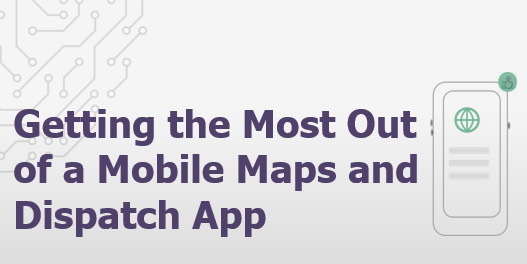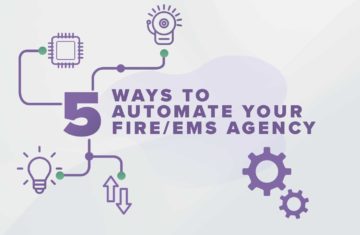Getting The Most Out of a Mobile Maps and Dispatch App
Considering adopting a mobile maps and dispatch app solution for first responders should be top of mind. Learn about the basics of mobile maps and dispatch app technology, the benefits for fire/EMS agencies, and features to look for when selecting a solution.
For fire/EMS Departments, dispatching your first responders efficiently and safely is paramount to keeping your organization running effectively. With mobile maps and dispatch app technology you can ensure your first responders in the field follow the safest and fastest route possible to a dispatch. But there are even more benefits to implementing this technology than just routing.
Below, we talk about the basics of mobile maps and dispatch app technology, the benefits for fire/EMS agencies, and features to look for when selecting a mobile maps and dispatch solution.
Basics of a Mobile Maps and Dispatch App
Mobile maps and dispatch technology empowers fire/EMS agencies by providing first responders with critical location, routing, and dispatch information while in the field. Fire/EMS agencies can use this data to plan, make better-informed decisions, and most importantly, respond to incidents safely and efficiently.
Mobile maps and dispatch technology integrates with an agency’s fire station’s automated alerting solution and CAD system. When an incident occurs, authorized personnel on duty receive notifications with vital dispatch and mapping information. Typically, the map(s) show where an incident is taking place, and also provides directions to the incident.
Advantages of Using Maps and Dispatch App
An automated mobile maps and dispatch app will offer a wide range of benefits to fire/EMS agencies and the communities they serve. Some key benefits of this mobile technology include:
Streamlined workflows for dispatching and managing incidents
The best mobile maps and dispatch solutions should address the needs of first responders with an easy to deploy and easy to use app that includes workflows for dispatching and managing incidents. It also provides first responders in the field with incident-critical information to respond effectively to a call. First responders can use the technology to receive complete dispatch information such as, apparatus, incident type, as well as turn-out time details.
Mobile solutions allow fire/EMS first responders to make better-informed decisions by improving their awareness of routing to an incident quickly, but it also enhances their awareness and knowledge about the incident and incident location before they arrive on the scene. Through a mobile map and dispatch app they can identify where the nearest fire hydrants or hospital facilities are located, which can be particularly helpful for volunteer personnel or new hires who may not be as familiar with a location. If a mobile map and dispatch app provides easy to understand visual markers of the incident type (structure fire, explosion, etc.), and real-time views of the affected structure(s) and surrounding area before they arrive at a call, they will be able to carry out their work more efficiently and effectively at the location.
Along with getting vital incident details, a mobile map and dispatch technology should allow responders to keep track of recent incidents and have the ability to ‘star’ or save dispatches that they want to refer to later for reference or follow-up. The app technology, if designed correctly, will also allow personnel to search a recent list of incidents using a variety of data points (i.e., incident type, address, unit, etc.) to find dispatch information when they need it. The data should be easy to access – by quickly tapping, swiping, or scrolling, first responders get the information they need, when they need it.
Improved communication and coordination
An effective maps and dispatch app will also improve supervisors, dispatchers, and field personnel’s communication and coordination abilities within a department, as well as with other agencies. The right map and dispatch technology will allow an agency to receive notifications to be sent out to personnel individually or as a group (battalion, station, district, etc.) wherever they are. Responders can use the app to see what units and engines are responding to a call in real-time and see where those units are on a map. The app can improve first responders’ ability to respond more nimbly if an incident requires more back-up from their own agency or another, or to see who’s responding to send updates and coordinate strategies for responding to a call.
What to Look for in a Maps and Dispatch App
There are a number of mobile map and dispatch app solutions on the market today, so it is best to be as informed as possible as you work to get buy-in from stakeholders or prepare to apply for a grant to finance a mobile solution. Consider the following key features and characteristics in your buying decisions:
Come with real-time alerts
A mobile map and dispatch app that is designed for the needs of fire/EMS dispatching, should be tied directly to your fire station alerting and CAD systems, to provide real-time alerts to first responders with complete incident data.
Provide multiple map views
It is important that the mobile map and dispatch app offers multiple map views—satellite, mapping, and street view to display dispatch information and location of the emergency. Multiple map views provide first responders with a variety of perspectives of a specific area, enabling them to make better decisions about how to handle an emergency. The maps should also give first responders markers, which are visual cues of an incident type such as if the emergency is a fire, collapsed building, or a medical emergency and as previously discussed, are also useful for showing where essential infrastructure (like fire hydrants or hospitals) are situated in relation to the incident.
The app must also tie into standard direction apps like Google Maps or iOS Maps to the call site, so first responders can see the best route to an incident. Importantly, it should navigate first responders to the location of the incident, monitor the route as it is unfolding, and be able to help the responders quickly change direction if needed.
Enable communication
Mobile map and dispatch technology reduces the amount of effort fire/EMS personnel must go through to share information. A well-designed mobile map and dispatch solutions should allow agencies to customize incident codes to communicate quickly about an incident type. The app should also allow first responders to show unit positions on a map so that other personnel can see where they are, minimizing the amount of effort to locate each other by calling. With the right app, first responders can also acknowledge that they are responding to an incident and get a count of how many people are responding.
Offer configurable alerting
A well-designed mobile map and dispatch app for fire/EMS agencies will also allow first responders to notify their station that they are ‘on duty’ so that they can receive important dispatch notifications. It should also allow an agency to configure alerting by unit, station, department, and geographic location, which is helpful for multi-jurisdictional departments or departments that depend on volunteers.
Conclusion
Mobile map and dispatch solutions better inform personnel, whether at the station or in the field. The solutions address the needs of fire/EMS agencies to run more efficiently and effectively, which translates into safer and better communities.



